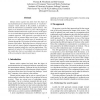Free Online Productivity Tools
i2Speak
i2Symbol
i2OCR
iTex2Img
iWeb2Print
iWeb2Shot
i2Type
iPdf2Split
iPdf2Merge
i2Bopomofo
i2Arabic
i2Style
i2Image
i2PDF
iLatex2Rtf
Sci2ools
FGR
2000
IEEE
2000
IEEE
Multiple Cues used in Model-Based Human Motion Capture
Human motion capture has lately been the object of much attention due to commercial interests. A ”touch free” computer vision solution to the problem is desirable to avoid the intrusiveness of standard capture devices. The object to be monitored is known a priori which suggest to include a human model in the capture process. In this paper we use a model-based approach known as the analysis-bysynthesis approach. This approach is powerful but has a problem with its potential huge search space. Using multiple cues we reduce the search space by introducing constraints through the 3D locations of salient points and a silhouette of the subject. Both data types are relatively easy to derive and only require limited computational effort so the approach remains suitable for real-time applications. The approach is tested on 3D movements of a human arm and the results show that we successfully can estimate the pose of the arm using the reduced search space.
| Added | 31 Jul 2010 |
| Updated | 31 Jul 2010 |
| Type | Conference |
| Year | 2000 |
| Where | FGR |
| Authors | Thomas B. Moeslund, Erik Granum |
Comments (0)

